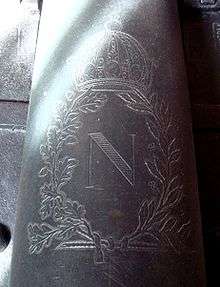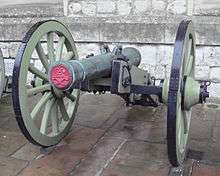Canon de 6 système An XI
| Canon de 6 système An XI | |
|---|---|
|
Canon de 6 système An XI, founded in Douay in 1813, Les Invalides | |
| Place of origin | France |
| Service history | |
| Used by | France |
| Wars | Napoleonic Wars |
| Production history | |
| Designer | Auguste de Marmont |
| Designed | 1803 |
| Produced | 1813 |
| Specifications | |
| Weight | 390 kg |
| Barrel length | 180 cm |
|
| |
| Caliber | 95.8 mm |
| Barrels | 1 |
The Canon de 6 système An XI was a French cannon and part of the Year XI system of artillery. It was part of the field artillery, and complemented the Gribeauval system.

Canon de 6 système An XI, detail.

Emblem of Napoleon I on an 1813 Canon de 6 système An XI
.

French 6 pounder field gun, cast in 1813 in Metz, captured at the Battle of Waterloo by the Duke of Wellington, now at the Tower of London.
The canon de 6 système An XI was used extensively during the Napoleonic wars. It was considered as a good intermediate between the Canon de 8 Gribeauval, considered to be too heavy for field artillery, and the Canon de 4 Gribeauval, considered as too light and lacking striking power.[1]
One of the characteristics of the Canon de 6 is that its design is even simpler than that of the Gribeauval cannons, as it lacks reinforcing mould rings, except for the one before the muzzle.[2]
See also
![]() Media related to Canon de 6 système An XI at Wikimedia Commons
Media related to Canon de 6 système An XI at Wikimedia Commons
Notes
References
- Chartrand, René 2003 Napoleon's guns 1792-1815 (1) ISBN 1-84176-458-2 Osprey Publishing
- Chartrand, René 2003 Napoleon's guns 1792-1815 (2) ISBN 1-84176-460-4 Osprey Publishing
This article is issued from Wikipedia - version of the 6/24/2016. The text is available under the Creative Commons Attribution/Share Alike but additional terms may apply for the media files.
